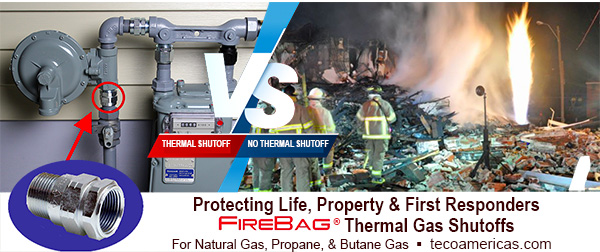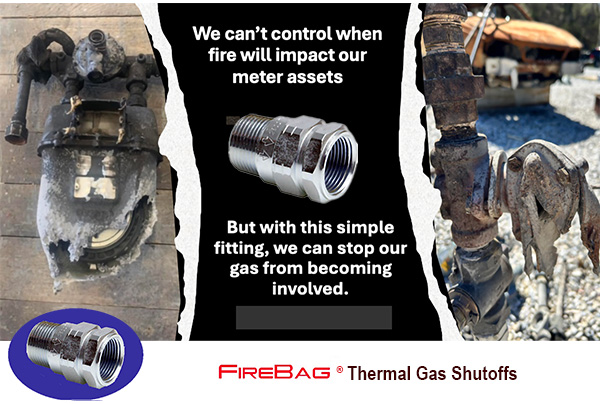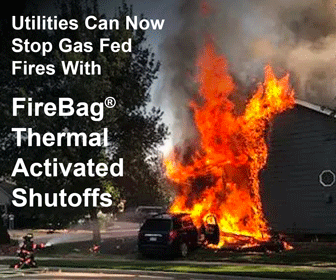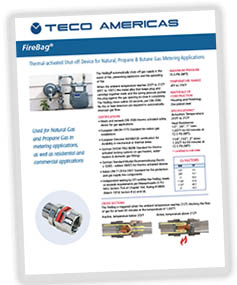Under Fire: Gas Meter Assemblies Undergo Critical Safety Tests
Natural gas is delivered to customers at high pressure, making the gas service regulator a critical safety component in the delivery network. This device safeguards customers and their premises by controlling the immense energy that could flow through the service line.
However, these regulators, installed above ground, are highly vulnerable to numerous hazards — especially fire. Constructed primarily of aluminum, plastic and rubber, gas regulators and meters fail under the heat of a fire. When they fail, they release high pressure gas, fueling dangerous fires.

The Fire Solutions Group. LLC recently conducted live testing of gas meter sets in simulated structure fire conditions at the York County Fire Academy in Pennsylvania. In every test gas regulators and meters failed, releasing high volumes of gas at significant velocity. The gas-fed fires were powerful, making them highly dangerous for first responders, and endanger rescue attempts. The manual shutoff valve, often located on the gas Riser near the meter, becomes inaccessible during a fire once the gas regulator and meter are compromised.
The Fire Solutions Group test series evaluated the impact of Class A burning materials on the components of a typical gas metering system, and demonstrated the effectiveness of the TECO® FireBag® thermal shutoff in preventing natural gas from becoming an additional fuel source in the fire.
A Class A fire, which has a burn rate of approximately 1200°F, is composed of solid materials such as wood or paper, fabric, and some plastics and is typical of a structure fire that could impact gas metering assets. As the fire progressed during testing, and the gas equipment failed due to exposure to the Class A fire, whereby the fire transitioned from a Class A to a more severe Class B fire due to the escaping gas from the regulator. Class B fires, which has a burn rate of approximately 3500°F, are more intense fires, as they are fueled by either liquids or gas accelerants such as alcohol, ether, natural gas, or gasoline.
The test setup included gas metering equipment comprising of valves, risers, regulators, and meters, as well as a FireBag Thermally Activated Shutoff (TAS), installed upstream of the regulator during certain tests. The tests involving a FireBag TAS was designed to test its efficacy in shutting off gas flow upon activation, and thereby eliminating natural gas as a source of fuel in the ensuing fire. The TAS activation times were recorded in relation to the failure of the regulators and meters.
During these tests, 7 residential gas meters and 9 gas regulators were exposed to a Class A fire. The heat of the Class A fire caused many of the meters’ aluminum casing and internal bellows to fail. The Class A fire also caused all 9 of the gas regulators to fail and vent gas — unless it was protected by an activated FireBag thermal shutoff.

Upon failure of the gas regulator or meter, temperature measurements indicated substantial increases, with recorded temperatures reaching levels consistent with natural gas fires. In tests where the FireBag was not installed in the riser, regulator and meter assembly, the temperature of the fire were significantly higher than those produced by Class A combustibles. Calculations based on gas flow rates provided insights into the additional heat release rate (HRR) contributed by natural gas, highlighting the heightened thermal exposure compared to typical Class A fires.
Notably, the FireBag TAS thermal shutoff demonstrated consistent efficacy in the tests by closing off gas flow upon activation, offering a vital safety measure in mitigating risks associated with equipment failures during fire exposure.
The test series highlighted the vulnerabilities of key components of gas metering equipment (regulators, aluminum cased meters, valves, and insulated unions) when exposed to Class A fires, and emphasized the importance of proactive safety measures, such as the FireBag TAS, in stopping the flow of gas to safeguard metering assets from increasing the potential hazard levels in commercial, industrial, and residential settings.
TECO FireBag Thermally Activated Shutoff (TAS) Features
- Fast activating trip temperatures of 203°-212°F, providing a gas-tight positive gas seal
- Once triggered, as per th DIN 3586 testing standards, the TECO FireBag TAS exceeds exposure temperatures at 1697°F for one hour
- Can undergo mechanical or thermal stress without misshaping, as thermal cooling occurs after a fire is extinguished.
- Tested & Approved for gas systems operating from inches water column to 150 psig MAOP
- Approved for Indoor & Outdoor piping applications
- NO external power or detectors required to activate
- Does not require regular inspections like active safety devices
- Approved for use by Massachusetts Department of Public Utilities (DPU) – Installation and Design of Automatic Gas Shut Off Devices G.L c. 164, § 75A (2012)
- Approved for use under CMR 248, Mass Fuel Gas & Plumbing Code (2011)
- Over 14.5M TECO FireBag devices installed worldwide, with greater than 300,000 in the United States.
Certifications
The TECO FireBag is certified for domestic and international thermal gas shutoff standards, including:
- Tested and certified by Gas Technology Institute (GTI) according to DIN 3586 testing procedures (2013).
- Tested under GTI OTD technical program comparing commercially available Thermal Activated Shutoffs (2019).
- Meets and exceeds DIN 3586 Thermal Activated Shutoffs for gas applications
- European UNI EN 1775 Standard for indoor gas installations
- European Directive 90/396/CEE certification for durability in mechanical or thermal stress
- German DVGW TRGI 86/96 Standard for thermo-activated locking systems on gas heaters, water heaters & domestic gas fittings
- German Standard Muster-Feuerverordnung (FeuVo v. 02/95 – edition 9/97) for thermal-activated devices
- Italian UNI 7129 Ed 2001 Standard for fire protection & gas supply line components
- How to Order TECO FireBag Thermal Shutoffs
View FireBag Video
Visit our video to get a fuller explanation and demonstration of where gas utilities install the FireBag for greater safety
Are Your Meter Sets Protected from Fire?
Share This Story
Resources
Contact Us Today!
All information is confidential and sent directly to a TECO Americas representative.
TECO® Americas, LLC
263 Cox Street Roselle, NJ 07203
inquiry@tecoamericas.com
Phone: 908-488-0909
https://tecoamericas.com




